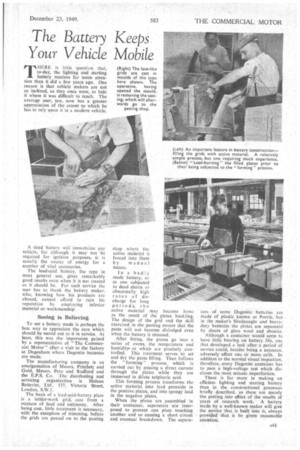The Battery Keeps
Page 59

If you've noticed an error in this article please click here to report it so we can fix it.
Your Vehicle Mobile
THERE is little question that, to-day, the lighting and starting battery receives far more attention than it did a few years ago. One reason is that vehicle makers are not so inclined, as they once were, to hide it where it was difficult to reach. The average user, too. now has a greater appreciation of the extent to which he has to rely upon it in a modern vehicle.
A dead battery will immobilize any vehicle, for although it may not be required for ignition purposes, it is usually the source of energy for a number of vital accessories.
The lead-acid battery, the type in most general use, gives remarkably good results even when it is not treated as it should be. For such service the user has to thank the battery maker, who, knowing how his products are abused, cannot afford to ruin his reputation by employing inferior material or workmanship.
Seeing is Believing To see a battery made is perhaps the best way to appreciate the care which should be meted out to it in service. At least, this was the impression gained by a representative of "The Commercial Motor after a visit to the factory at Dagenham where Dagenite batteries are made.
The manufacturing company is an amalgamation of Messrs. Pritchett and Gold, Messrs. Peto and Radford and the E.P.S. Co. The distributing and servicing organization is Holsun Batteries, Ltd., 137, Victoria Street, London, S.W.1.
The basis of a lead-acid-battery plate is a lattice-work gri!cl, cast from a mixture of Lead and antimony. After being cast, little treatment is necessary, with the exception of trimming, before the grids are passed on to the pasting In a badly made battery, or in one subjected to dead shorts or abnormally high rates of discharge for long periods, the active material may become loose as the result of the plates buckling. The design of the grid and the skill exercised in the pasting ensure that the paste will not become dislodged even when the battery is misused.
After fitting, the plates go into a series of ovens, the temperature and humidityin which are precisely controlled. This treatment serves to set and dry the paste filling. Then follows the "forming" process, which is carried out by passing a direct current through the plates while they are immersed in dilute sulphuric acid.
This forming process transforms the active material into lead peroxide in the positive plates, and into spongy lead in the negative plates.
When the plates are assembled in their container, separators are interposed to prevent one plate touching another and so causing a short circuit and eventual breakdown. The separa
tors of some Dagenite batteries are made of plastic known as Porvic, but in the maker's Shednought and heavyduty batten:es the plates are separated by sheets of glass wool and ebonite.
Although a container would seem to have little bearing on battery life, one that developed a leak after a period of service could, besides being a nuisance, adversely affect one or more cells. In addition to the normal visual inspection. therefore, every Dagenite container has to pass a high-voltage test which discloses the most minute imperfection.
There is far more in making an efficient lighting and starting battery than in the constructional processes briefly described, as these are merely the putting into effect of the results of years of research work. A battery made by a well-known maker will give the service that is built into it, always provided that it be given reasonable attention.




















































































